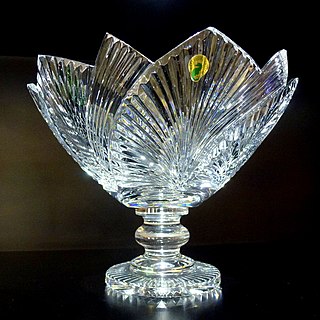
Art glass is a subset of glass art, this latter covering the whole range of art made from glass. Art glass normally refers only to pieces made since the mid-19th century, and typically to those purely made as sculpture or decorative art, with no main utilitarian function, such as serving as a drinking vessel, though of course stained glass keeps the weather out, and bowls may still be useful.

Steuben Glass is an American art glass manufacturer, founded in the summer of 1903 by Frederick Carder and Thomas G. Hawkes in Corning, New York, which is in Steuben County, from which the company name was derived. Hawkes was the owner of the largest cut glass firm then operating in Corning. Carder was an Englishman who had many years' experience designing glass for Stevens & Williams in England. Hawkes purchased the glass blanks for his cutting shop from many sources and eventually wanted to start a factory to make the blanks himself. Hawkes convinced Carder to come to Corning and manage such a factory. Carder, who had been passed over for promotion at Stevens and Williams, consented to do so.

A chandelier is an ornamental lighting device, typically with spreading branched supports for multiple lights, designed to be hung from the ceiling. Chandeliers are often ornate, and they were originally designed to hold candles, but now incandescent light bulbs are commonly used, as well as fluorescent lamps and LEDs.

Waterford Crystal is a manufacturer of lead glass or "crystal", especially in cut glass, named after the city of Waterford, Ireland. In January 2009, the main Waterford Crystal manufacturing base on the edge of Waterford was closed due to the insolvency of Waterford Wedgwood PLC, and in June 2010, Waterford Crystal relocated almost back to the roots of glass-making in the city centre. The Mall location holds both a manufacturing facility that melts over 750 tonnes of crystal a year - although most Waterford Crystal is now produced outside Ireland - and a visitor centre with the world's largest collection of Waterford Crystal. As of 2015, the brand is owned by the Fiskars Corporation.

Dartington Crystal is a British manufacturer of crystal glassware and is based in the town of Torrington in North Devon, England. The company manufactures their glassware using traditional glass blowing techniques.
Swarovski is an Austrian producer of glass based in Wattens. It was founded in 1895 by Daniel Swarovski.

Citizen Watch Co., Ltd. is an electronics company primarily known for its watches and is the core company of a Japanese global corporate group based in Nishitokyo, Tokyo, Japan. In addition to Citizen brand watches, it is the parent of American watch company Bulova, and is also known for manufacturing small electronic devices such as calculators.
Wordsley is a suburban area of Stourbridge in the West Midlands, England. It is part of the Metropolitan Borough of Dudley and falls into the Stourbridge (DY8) postcode and address area, being just north of the River Stour. Wordsley is part of the Dudley South Parliamentary constituency. It is bordered by open Staffordshire countryside to the west, Kingswinford to the North, Brierley Hill to the East and Stourbridge to the South.
Frederick Carder was a glassmaker, glass designer, and glass artist who was active in the glass industry in both England and the United States, notably for Stevens & Williams and Steuben, respectively. Known for his experimentation with form and color, Carder's work remains popular among collectors and can be found in numerous museum collections, including The Corning Museum of Glass, which houses theFrederick Carder Gallery, Chrysler Museum of Art, and the Detroit Institute of Arts. He was born in Staffordshire, England, and died in Corning, New York, where he had made his home in 1903.

Edinburgh Crystal was a cut glass manufactured in Scotland from c. 1820s to 2006, and was also the name of the manufacturing company. In addition to drinking glasses, Edinburgh Crystal made decanters, bowls, baskets, and bells, in several ranges.
Cambridge Glass was a manufacturer of glassware formed in 1873 in Cambridge, Ohio. The company produced a range of coloured glassware in the 1920s, initially with opaque shades, but moving on to transparent shades by the end of the decade. Unable to compete with mass-produced glassware, the company closed briefly in 1954, but was reopened in 1955. However, financial difficulties persisted, and, after several ownership changes, the factory closed for good in 1958. Imperial Glass Company purchased the Cambridge Glass molds two years later, and would use them for another three decades until that company went bankrupt in 1984.

Bohemian glass, also referred to as Bohemia crystal, is glass produced in the regions of Bohemia and Silesia, now parts of the Czech Republic. It has a centuries long history of being internationally recognised for its high quality, craftsmanship, beauty and often innovative designs. Hand-cut, engraved, blown and painted decorative glassware ranging from champagne flutes to enormous chandeliers, ornaments, figurines and other glass items are among the best known Czech exports and immensely popular as tourist souvenirs. The Czech Republic is home to numerous glass studios and schools attended by local and foreign students.

Rückl Crystal is a Bohemian glass factory in the village of Nižbor, about 7 km west from the city of Beroun, Czech Republic. The glass factory produces 24% lead crystal. The major part of its production is focused on export, but some production is for the market in the Czech Republic.

Moser a.s. is a luxury glass manufacturer based in Karlovy Vary, Czech Republic. The company is known for manufacturing stemware, decorative glassware, glass gifts and various art engravings. Moser is one of the most collected of 20th century decorative glass and has been used everywhere from palaces to local restaurants. From its beginnings in 1857, as a polishing and glass engraving workshop, it developed into a lead-free glass manufacturer lasting through the 20th century until the present. It is considered as the most luxurious Czech brand as well as one of the world's most famous brands of luxury crystal. Every piece of glass that is made by Moser is hand made.
Preciosa is the luxury brand name for the range of precision-cut lead crystal glass and related products produced by Preciosa a.s. of Jablonec nad Nisou, Czech Republic.
Nachtmann or F. X. Nachtmann Bleikristallwerke GmbH was a fine glass maker, founded in 1834 by Michael Nachtmann in Unterhütte, Oberpfalz. In 1900 the company was taken over by Zacharias Frank who moved the headquarters to Neustadt an der Waldnaab.
Royal Brierley is a fine cut glass brand, owned by Dartington Crystal and based in North Devon. It is one of the oldest crystal glass brands in England.

Ajka Crystal has been one of the most prestigious workshops in the European glass industry since its founding in 1878.

RONA a.s. is a Slovak drinking glass manufacturer, established in Lednické Rovne, Slovakia, in 1892. The name RONA comes from the former naming of the village ‘‘Lednicz Rone’’. The company manufactures unleaded drinking glasses, known as crystal glass. 96% of production is exported and is available in more than 80 countries worldwide. The yearly production of the company exceeds 60 million pieces (2016). Product segments include households, the gastronomy business, aerospace, and ship catering.

A glass flute or crystal flute is a glass instrument briefly popular in the early 19th century. They are an unusual variety of the Western concert flute designed to preserve pitch and tone during temperature change better than the wood and ivory flutes available at the time of their manufacture. Most were made by Claude Laurent, a French craftsman and clockmaker who patented the leaded crystal glass flute in 1806. They became obsolete after metal flutes were produced. Other than sounding more consistent at differing temperatures, glass flutes are similar in tone to contemporary wooden and ivory flutes.













